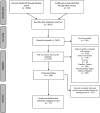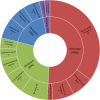Virtual and augmented reality applications to improve older adults' quality of life: A systematic mapping review and future directions
- PMID: 36339904
- PMCID: PMC9629585
- DOI: 10.1177/20552076221132099
Virtual and augmented reality applications to improve older adults' quality of life: A systematic mapping review and future directions
Abstract
Objective: The use of virtual reality and augmented reality to improve older adults' quality of life has rapidly increased in recent years. This systematic mapping review aimed to provide a comprehensive overview of existing research that identifies and classifies current virtual reality and augmented reality applications that enhance the quality of life of older adults to increase the understanding of the impact of these technologies.
Methods: To reach this objective, a systematic mapping review was conducted of the studies published between 2009 and 2020 in major scientific databases, such as IEEE Xplore, Web of Science, Scopus, and PubMed. A total of 57 studies were analyzed and classified into four main quality of life domains: physical, cognitive, psychological, and social well-being.
Results: The findings showed that virtual reality and augmented reality have found their places in many quality of life studies of older adults. Although virtual reality and augmented reality applications are notably growing in the physical and cognitive well-being domains in training and rehabilitation settings, they are still in the early stages of development in psychological and social well-being research as well as healthcare settings. Our findings also revealed that virtual reality games, particularly motion-based exergames, and 3D augmented reality systems are the most common virtual reality and augmented reality types among the reviewed studies. Moreover, balance and attention were the most prevalent physical and cognitive functions when using motion-based and immersive virtual reality exergames and augmented reality systems and games, respectively, while confidence and interaction were the most dominant psychological and social functions.
Conclusion: This mapping review provides a comprehensive overview of potential areas for further research in this field, thereby assisting researchers, technologists, and health practitioners in expanding this field of research.
Keywords: Augmented reality; healthcare; older adults; quality of life; rehabilitation; training; virtual reality.
© The Author(s) 2022.
Conflict of interest statement
The author(s) declared no potential conflicts of interest with respect to the research, authorship, and/or publication of this article.
Figures









Similar articles
-
Experiences of older adults participating in dance exergames: A systematic review and meta-synthesis.Int J Nurs Stud. 2024 Apr;152:104696. doi: 10.1016/j.ijnurstu.2024.104696. Epub 2024 Jan 15. Int J Nurs Stud. 2024. PMID: 38301305
-
The Application of Fully Immersive Virtual Reality on Reminiscence Interventions for Older Adults: Scoping Review.JMIR Serious Games. 2023 Oct 6;11:e45539. doi: 10.2196/45539. JMIR Serious Games. 2023. PMID: 37801360 Free PMC article.
-
Factors That Influence Young Adults' Preferences for Virtual Reality Exergames in a Weight Control Setting: Qualitative Study.J Med Internet Res. 2024 Dec 30;26:e58422. doi: 10.2196/58422. J Med Internet Res. 2024. PMID: 39753223 Free PMC article.
-
The use of virtual reality and augmented reality in psychosocial rehabilitation for adults with neurodevelopmental disorders: A systematic review.Front Psychiatry. 2022 Dec 14;13:1055204. doi: 10.3389/fpsyt.2022.1055204. eCollection 2022. Front Psychiatry. 2022. PMID: 36590624 Free PMC article.
-
Virtual Reality for Pulmonary Rehabilitation: Comprehensive Review.JMIR Rehabil Assist Technol. 2023 Oct 2;10:e47114. doi: 10.2196/47114. JMIR Rehabil Assist Technol. 2023. PMID: 37782529 Free PMC article. Review.
Cited by
-
Effectiveness, safety and patients' perceptions of an immersive virtual reality-based exercise system for poststroke upper limb motor rehabilitation: A proof-of-concept and feasibility randomized controlled trial.Digit Health. 2023 Sep 26;9:20552076231203599. doi: 10.1177/20552076231203599. eCollection 2023 Jan-Dec. Digit Health. 2023. PMID: 37766909 Free PMC article.
-
Space Analogs and Behavioral Health Performance Research review and recommendations checklist from ESA Topical Team.NPJ Microgravity. 2024 Oct 22;10(1):98. doi: 10.1038/s41526-024-00437-w. NPJ Microgravity. 2024. PMID: 39433767 Free PMC article. Review.
-
VR Cognitive-based Intervention for Enhancing Cognitive Functions and Well-being in Older Adults with Mild Cognitive Impairment: Behavioral and EEG Evidence.Psychosoc Interv. 2025 Jan 2;34(1):37-51. doi: 10.5093/pi2025a4. eCollection 2025 Jan. Psychosoc Interv. 2025. PMID: 39781014 Free PMC article.
-
Age-related differences in upper limb motor performance and intrinsic motivation during a virtual reality task.BMC Geriatr. 2023 Apr 27;23(1):251. doi: 10.1186/s12877-023-03970-7. BMC Geriatr. 2023. PMID: 37106330 Free PMC article.
-
Explore the extended impacts on psychological well-being in older adults through application of virtual reality technology: An integrative review.Int J Nurs Stud Adv. 2025 Jun 27;9:100371. doi: 10.1016/j.ijnsa.2025.100371. eCollection 2025 Dec. Int J Nurs Stud Adv. 2025. PMID: 40686631 Free PMC article.
References
-
- Bowling A. Quality of life in older age: What older people say. In: Mollenkopf H and Walker A (eds) Quality of life in old age. Dordrecht: Springer, 2007, pp.15–30.
-
- Hasan H, Linger H. Enhancing the wellbeing of the elderly: Social use of digital technologies in aged care. Educ Gerontol 2016; 42: 749–757.
-
- Vanleerberghe P, De Witte N, Claes Cet al. et al. The quality of life of older people aging in place: A literature review. Qual Life Res 2017; 26: 2899–2907. - PubMed
-
- Riva G, Gaggioli A, Villani D, et al. Positive technology for healthy living and active ageing. In: Active ageing and healthy living: A human centered approach in research and innovation as source of quality of life. IOS Press, 2014, pp.44–56. - PubMed
-
- Şahin DS, Özer Ö, Yanardağ MZ. Perceived social support, quality of life and satisfaction with life in elderly people. Educ Gerontol 2019; 45: 69–77.
Publication types
LinkOut - more resources
Full Text Sources

